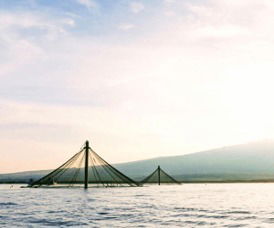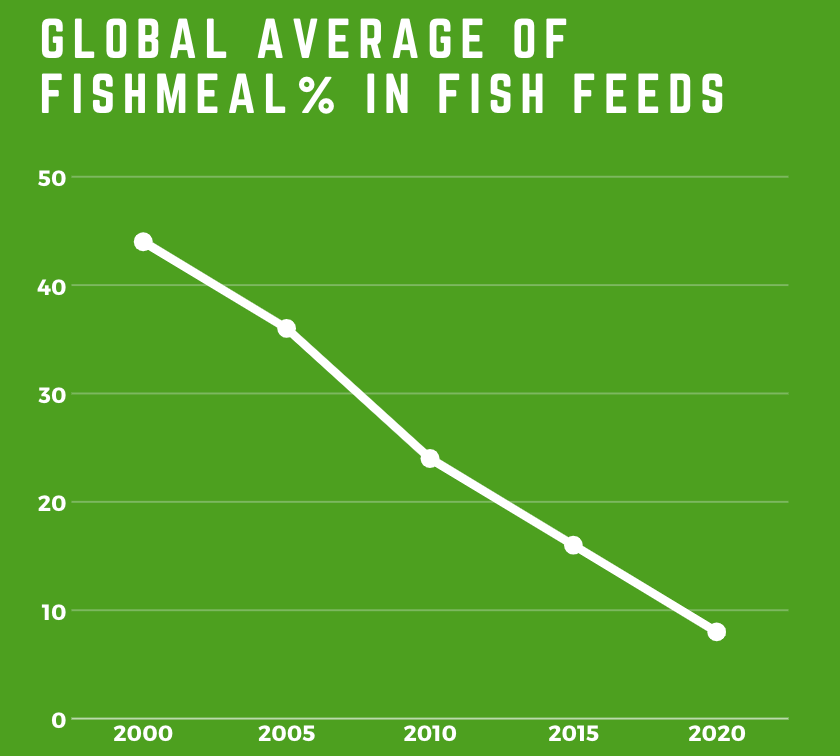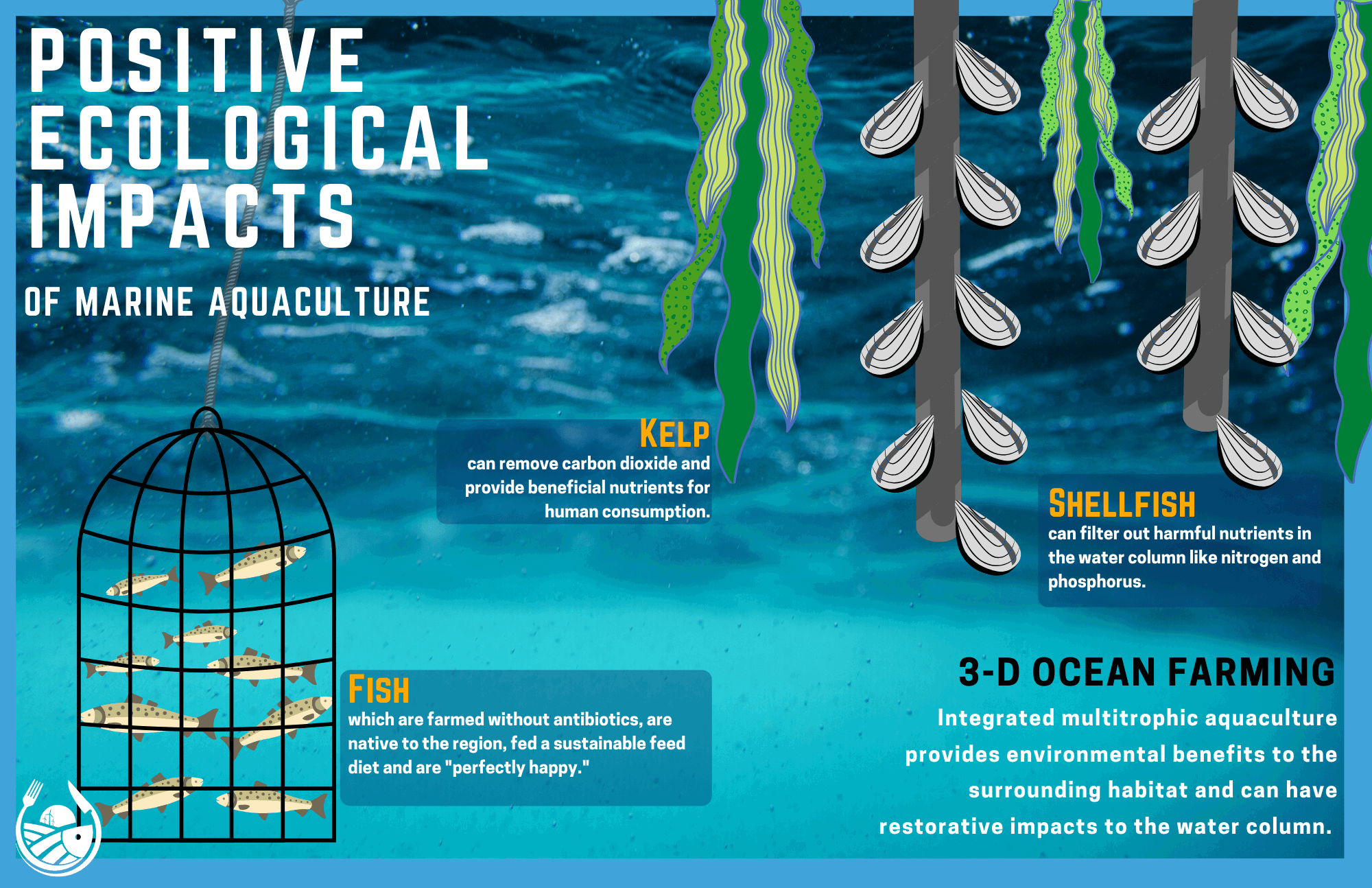The New Farmed Fish: Today Does Not Equal Yesterday

Written by Corinne Noufi and Jess McCluney
Feature photo courtesy of Blue Ocean Mariculture
Discovering differences between fish farms and livestock production
It's a new day for today's farmed fish
Confined animal feed lots for cattle, caged hens, and crated pigs: these conventional systems still dominate our livestock production. But not all animal production is created equal, as witnessed by the rise of pasture-raised and free-range livestock models producing more and more commercially viable products. Just as solutions to less palatable conventional animal systems have arisen, transitioning toward more sustainable practices, solutions to distasteful methods of fish farming have also arisen in the form of forward-thinking sustainable aquaculture practices. This article will highlight some of the notable advancements in aquaculture that are consistently being implemented in today's farmed fish, and its potential to surpass niche livestock practices as these responsible practices become mainstream across aquaculture systems. It's a new day for today's farmed fish.
Today’s farmed fish is a closer comparison to pasture-raised and free-range products
Similar to the evolution of pasture-raised and free-range livestock models, today’s farmed fish production systems have evolved to demonstrate a more environmentally-conscious, nutritious, and more humane way to produce food as consumers continue to demand better. Blue Ridge Aquaculture in Virginia is the largest indoor tilapia farm in the world, and one example of how today’s farmed fish techniques can differ from when they began 27 years ago. From their purchase of the farm in 1993, modifications and innovations to their indoor recirculating tanks have improved their design and equipment, eliminated all diseases, and led to the development of their own feed mill and control over their own fish feed.1 7 As Bill Martin, fish farmer and owner puts it, “my model is the poultry industry…The difference is, our fish are perfectly happy.”
This article presents an overview of some key advances in aquaculture practices over the past 30 years, touching on topics of antibiotics usage, feed usage, escapement concerns, and even highlighting methods with a positive impact on the ecosystem.
Antibiotics usage in food and animals
Antibiotics usage has decreased over time across environmentally-conscious livestock and aquaculture
The overwhelming majority of livestock is still raised with antibiotics as the status quo despite repeated medical evidence pointing to superbugs.13 Yet some beef farmers, like those affiliated with Carman Ranch, have begun to demonstrate it is quite possible to raise healthy farmed animals without using antibiotics and the aquaculture industry is doing the same.2 While it depends on the country and even the farm, the use of antibiotics has largely become a thing of the past in many forward-focused aquaculture operations, due among other factors to the modern availability of common vaccines.
Vaccine development for aquaculture application
As early as the 1990’s government agencies, fish farmers, and medical experts began collaborating with support from the World Health Organization to produce the first safe-for-consumption vaccine in the aquaculture industry.18 Since then, over 50 vaccinations have been developed as a safer way to maintain healthy fish, as medical experts have addressed concerns that antibiotics in our food system can have negative impacts on our health.
Overall decrease in antibiotics usage
Whil Love, D. C., Fry, J. P., Cabello, F., Good, C. M., & Lunestad, B. T. (2020).e there are certainly still diseases which require antibiotic treatment, it is rarely necessary when the fish are allowed to live in proper conditions, in which more and more of today’s farmed fish are. In the United States the use of antibiotics has decreased by over 33% since 2012.9 Maine has completely stopped all antibiotic use in aquaculture as of 2007.9 Norway, an excellent example of responsible farming and appropriate antibiotic usage, has led the way in reducing antibiotic usage in fish farming (mostly salmon), where less than 1% of the fish farmed in Norway is exposed to antibiotics – an all-time low.18 There, when antibiotics are applied for treatment, the affected fish are quarantined until all antibiotic residue is gone before they can be harvested.10 17
Love, D. C., Fry, J. P., Cabello, F., Good, C. M., & Lunestad, B. T. (2020).e there are certainly still diseases which require antibiotic treatment, it is rarely necessary when the fish are allowed to live in proper conditions, in which more and more of today’s farmed fish are. In the United States the use of antibiotics has decreased by over 33% since 2012.9 Maine has completely stopped all antibiotic use in aquaculture as of 2007.9 Norway, an excellent example of responsible farming and appropriate antibiotic usage, has led the way in reducing antibiotic usage in fish farming (mostly salmon), where less than 1% of the fish farmed in Norway is exposed to antibiotics – an all-time low.18 There, when antibiotics are applied for treatment, the affected fish are quarantined until all antibiotic residue is gone before they can be harvested.10 17
Aquaculture feed usage
Aquaculture feed advancements in the past 20 years
Nutrition innovations in today’s farmed fish have resu FAO. (n.d.). The State of World Fisheries and Aquaculture 2016.lted in more efficient feeds allowing the already low feed conversion ratio to drop even further. Explore our article for a deeper dive into feed usage and efficiency to learn more. With the innovative feeds, farmers are able to grow carnivorous fish on mostly plant-based feed diets containing natural carotenoids (the orange-red pigments found in fruits and vegetables) to retain their natural flesh color. Trending away from fishmeal in feed, farmers have been able to produce larger and faster growing fish of the same species compared to fish on fishmeal diets. Within in the last two decades, the amount of fish oil and fishmeal from wild fish in feed has decreased over 60% with creative replacements such as insects, algae, and yeast. Such ingenuity has continued aquaculture down the path to a more sustainable and healthier way of nourishing their fish.
FAO. (n.d.). The State of World Fisheries and Aquaculture 2016.lted in more efficient feeds allowing the already low feed conversion ratio to drop even further. Explore our article for a deeper dive into feed usage and efficiency to learn more. With the innovative feeds, farmers are able to grow carnivorous fish on mostly plant-based feed diets containing natural carotenoids (the orange-red pigments found in fruits and vegetables) to retain their natural flesh color. Trending away from fishmeal in feed, farmers have been able to produce larger and faster growing fish of the same species compared to fish on fishmeal diets. Within in the last two decades, the amount of fish oil and fishmeal from wild fish in feed has decreased over 60% with creative replacements such as insects, algae, and yeast. Such ingenuity has continued aquaculture down the path to a more sustainable and healthier way of nourishing their fish.
Fish escapement risk
Escapement risk eliminated for land-based farms
Anecdotally, we know livestock have been busting through fences and wreaking their own form of havoc since humans began fencing them in. But one widespread concern unique to aquaculture, as differentiated from farmed livestock, is the concern around the consequences of a fish escapement event. Thankfully, the actual number of salmon escapes over the past 15 years have dropped a whopping 98%.15 Considering that open net pens are the primary farming method at risk for escapement, and that open net pens have historically been the dominant method to raise salmon, that decrease highlights a rather significant change. Contributing reasons to this decline are that production methods in the U.S. have shifted toward closed systems on land such as raceways and recirculation systems, completely eliminating escapement risk. For caged and net pen systems in nearshore or offshore aquatic environments, actions to mitigate risk include improved quality and monitoring control coupled with advancements in structural material and engineering design. For a deeper dive into escapement risks, read this article.
Positive ecological impacts of aquaculture
Preventing waste buildup and preserving water quality on aquatic farms
Best practices for grazing livestock include the continuous relocation of farmed animals to allow for rejuvenation and healing of the pastured land, a leading example being Polyface Farms who frequently moves around their farmed cows and chickens.11 Lesser known is that the aquaculture industry has its own version of this regenerative practice. Some fish farmers in Maine continuously move their net pens from farm site to farm site preventing waste buildup and keep up with more balanced nutrient cycling. 14 16
A holistic approach to fish farming: multi-trophic aquaculture
The concept that raising different animals and plants together results in lower feed cost, utilization of otherwise waste products, greater land productivity, and improved environmental health is not new.12 In fact, integrating livestock into holistic farming can be traced back to the 1940’s as an entrepreneurial idea.3 This holistic approach has not fallen deaf to today’s farmed fish industry either, whose development of integrated multi-trophic aquaculture or 3-D ocean farming, incorporates benefits from the surrounding ecosystem and neighboring wild species. This model employs bivalves like mussels and oysters to filter out fish waste and toxins and kelp to absorb excess carbon, cleaning nearby ocean habitat while sustainably providing food for humans.4 8 More information on this holistic approach can be found in our article discussing environmental impacts of different animal proteins.
Home to one of five USDA national aquaculture research centers, Maine is on the forefront of these types of technological advancements, paving the way for the future of aquaculture in the nation.5 Supported by NOAA’s National Sea Grant Program and Maine Sea Grant, researchers from various organizations and education institutions have received over 1.5 million dollars in funding for the continued exploration of technological advancements in aquaculture, food safety, and market development.6 With Maine paving the way and more states following suit, aquaculture has a huge potential to benefit the U.S.
Moving forward with today's farmed fish
Eating to save the planet
We wish to highlight some of the notable advancements in aquaculture which are consistently being implemented in today’s farmed fish. While aquaculture has made great strides in the past 30 years, evolving common industry practices to those more closely resembling the way responsible livestock is raised versus conventional methods, we acknowledge that not every concern since the beginning of industrialized aquaculture has been addressed, or, as with livestock, incorporated into the majority of standard global practice. Yet in a country who lags behind the rest of the world in terms of aquaculture production, the US is well-positioned to continue heading toward farmed fish as a more sustainable future of food production. According to Danielle Blacklock, Director of NOAA Fisheries Office of Aquaculture,
“As a nation we have advanced sustainable feeds research, best management practices, and even disease-resistant brood stock. However, we remain a small aquaculture producer on a global scale. Moving forward, the US is focused on capitalizing the economic, environmental, and social benefits that sustainable aquaculture presents. Much like the US wild-capture industry, we hope to make US aquaculture industry the gold standard for responsibly produced seafood”.
In terms of our everyday grocery choices, responsible farmed fish like the examples laid out in this article, complements sustainable wild fish just as it compliments restorative practices behind high-end livestock and agricultural products we aspire toward in order to eat better for our planet.
SOURCES
1.Blue Ridge Aquaculture. (n.d.). Retrieved from http://www.blueridgeaquaculture.com/aboutus.cfm
2.Carman Ranch. (2020). Retrieved from https://www.carmanranch.com/pages/faqs-3
3.Case, A. N. (2014). Idealizing an Organic Landscape: J. I. Rodale, the Rodale Press, and the Pennsylvania Countryside. The Pennsylvania Magazine of History and Biography, 138(1), 73. doi: 10.5215/pennmaghistbio.138.1.0073
4.Chopin, T., Cooper, J. A., Reid, G., Cross, S., & Moore, C. (2012). Open-water integrated multi-trophic aquaculture: environmental biomitigation and economic diversification of fed aquaculture by extractive aquaculture. Reviews in Aquaculture, 4(4), 209–220. doi: 10.1111/j.1753-5131.2012.01074.x
5.du Hoax, R. (2020). Maine is becoming a leader in aquaculture with salmon research. Maine Insights, (63).
6.Haverkamp, H. (2019, September 19). NOAA Sea Grant National Aquaculture Initiative awards $1.6M to advance sustainable aquaculture in Maine . UMaine News. Retrieved from https://umaine.edu/news/blog/2019/09/19/noaa-sea-grant-national-aquaculture-initiative-awards-1-6m-to-advance-sustainable-aquaculture-in-maine/
7.Huffman, J. (2018, May 3). US RAS tilapia farm integrates to survive, but it's lonely. Retrieved from https://www.undercurrentnews.com/2018/05/03/us-ras-tilapia-farm-integrates-to-survive-but-its-lonely/
8.Kelly, E. D., Heidkamp, P. D., & Miller, M. D. (2017). Assessing the Transition Potential of 3D Ocean Farming in Long Island Sound. Regions Magazine, 307(1), 19–21. doi: 10.1080/13673882.2017.11889961
9.Love, D. C., Fry, J. P., Cabello, F., Good, C. M., & Lunestad, B. T. (2020). Veterinary drug use in United States net pen Salmon aquaculture: Implications for drug use policy. Aquaculture, 518, 734820. doi: 10.1016/j.aquaculture.2019.734820
10.Nsc. (n.d.). The Truth about Norwegian Farm Raised Salmon. Retrieved from https://seafoodfromnorway.us/origin/Norway-the-worlds-leader-in-aquaculture/the-truth-about-norwegian-farm-raised-salmon/
11.Polyface Farms. (2018). Retrieved from http://www.polyfacefarms.com/principles/
12.Rodale Institute. (2020). Crop Livestock Integration. Retrieved from https://rodaleinstitute.org/science/crop-livestock-integration/
13.Robbins, J. (2012). No happy cows: dispatches from the frontlines of the food revolution. San Francisco, CA: Conari Press.
14.Rust, M. B., Amos, K. H., Bagwill, A. L., Dickhoff, W. W., Juarez, L. M., Price, C. S., Rubino, M. C. (2014). Environmental Performance of Marine Net-Pen Aquaculture in the United States. Fisheries, 39(11), 508–524. doi: 10.1080/03632415.2014.966818
15.Salmon Facts. (2016, May 26). Escaped fish. Retrieved from https://salmonfacts.com/salmon-and-environment/escaped-fish/
16.Southern Land Exchange. (2018, February 5). Fishing for Information: The Environmental Impact of Fish Farming. Retrieved from https://www.southernlandexchange.com/fishing-for-information-the-environmental-impact-of-fish-farming/
17.The Fish Site. (2018, November 15). Debunking the antibiotics myth. Retrieved from https://thefishsite.com/articles/debunking-the-antibiotics-myth
18.World Health Organization. (2015, October 12). Vaccinating salmon: How Norway avoids antibiotics in fish farming. Retrieved from https://www.who.int/features/2015/antibiotics-norway/en/
